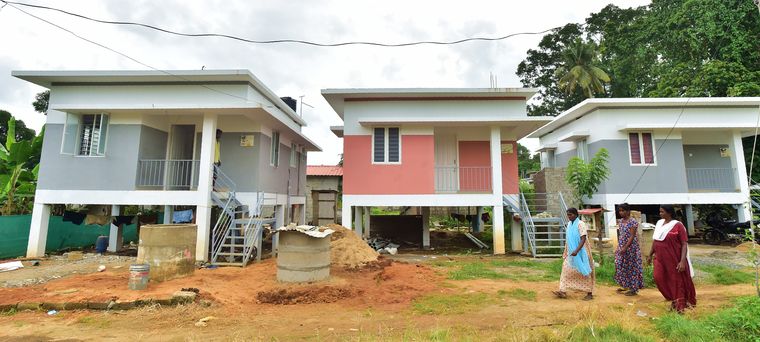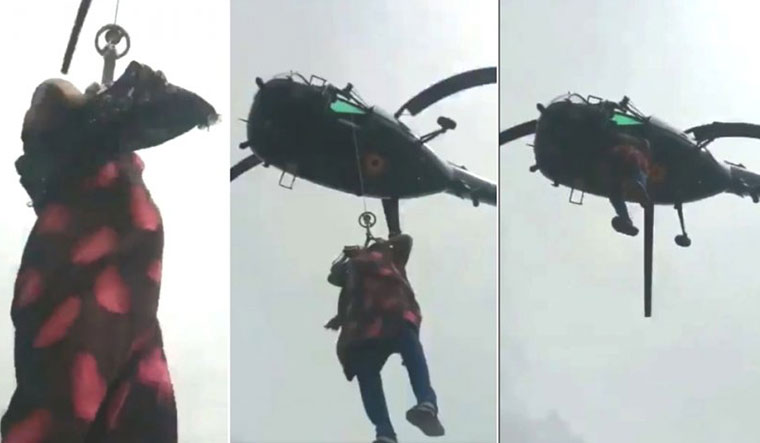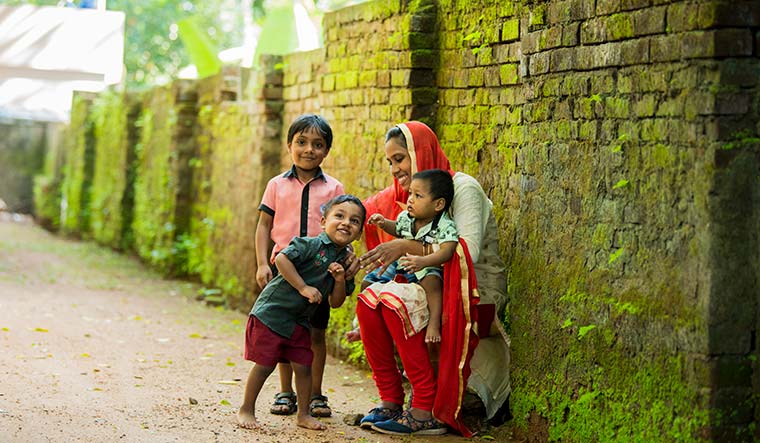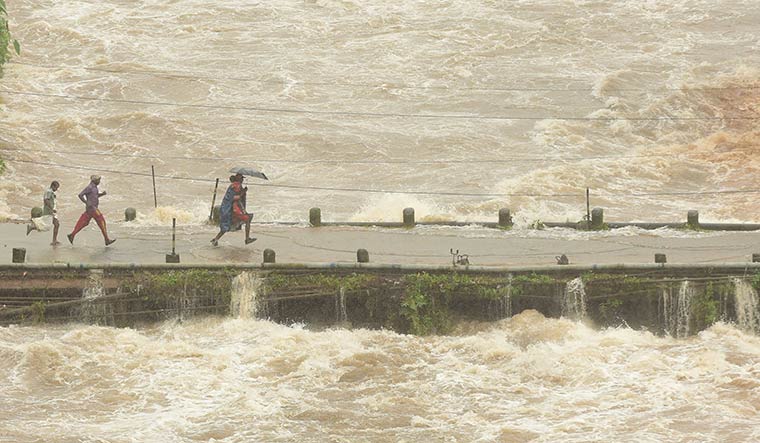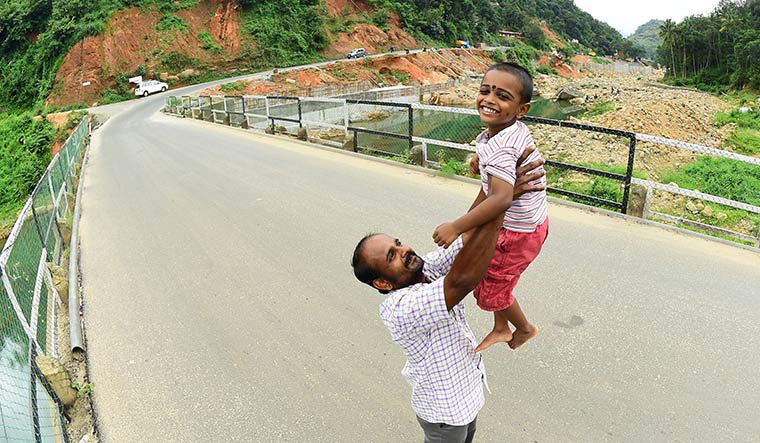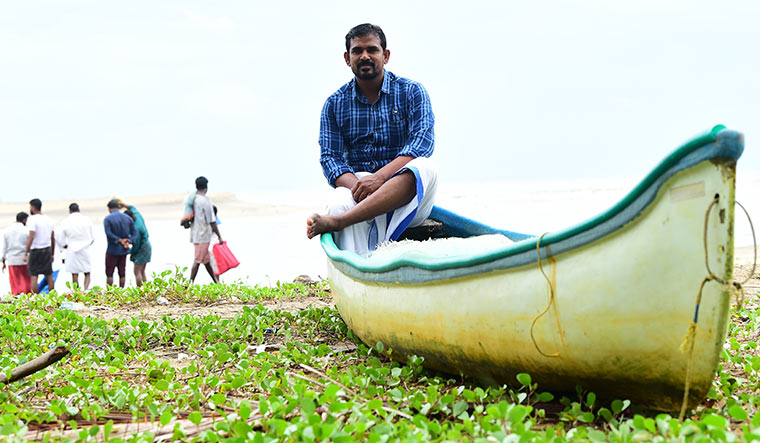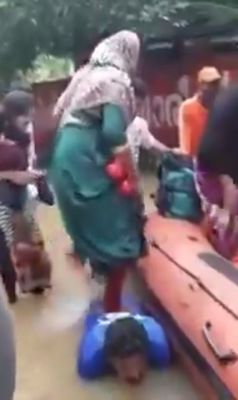Rain does not evoke romantic thoughts in the minds of many Malayalis now. For them, all that it brings back are the dark images of gushing water, loud cries, people stranded on rooftops, uprooted tress and floating bodies.
One year has passed since the mega-flood ravaged Kerala. And the fear is quite palpable even now. “I am scared of rains. Whenever I see clouds getting darker, I remember those days. Suddenly I feel a gnawing pain inside me,” said Sajitha Jabil, who was in the last days of her pregnancy when the flood happened. Sajitha was airlifted by a Navy helicopter, and she gave birth immediately after reaching the hospital.
Far away, on a hilltop in Idukki district, Anil, a tribal youth, sleeps only when sun is about to rise. “What if there is cloudburst in the night, as it did last year, and landslides happen? We all will be deep inside the sludge. So I stay awake as others sleep,” he said.
An entire neighbourhood had got flattened by rocks and sludge even as he watched helplessly. “It was raining heavily, but still my hands can feel the warmth of that kid whose body I unearthed,” said Anil, rubbing his hands heavily, as if to remove the memory of that warmth. “The truth is that I am unable to sleep.”
Joseph K. from Kalady in Ernakulam district still shuts his eyes every time he sees a water body. He had stayed on a rooftop amid gushing waters on the banks of the river Periyar for four days. “I shudder at the sight of dark clouds and the sound of rains. Even the sight of a calm lake unnerves me,” he said.
Fear is everywhere, in various shades. Such was the agony of those days. The non-stop downpour which started on August 14 and continued for four days took 483 lives and affected 54 lakh people. The state had a total financial loss to the tune of Rs30,000 crore. As many as 5.78 lakh houses were destroyed; 50,000 homes disappeared without a trace. The flood destroyed Kerala’s intricate road network; 80,000km of roads and 218 bridges were either damaged or washed away. Agricultural loss in 56,439.19 hectares had amounted to more than Rs1,345 crore.
Kerala did face the unprecedented deluge with aplomb. The death toll was low, thanks to the selfless camaraderie of the people.
But scars are everywhere. Many families are still living apart as houses are yet to be built.The hilly terrains of Idukki district, where a number of dams are located, faced the highest loss in terms of lives and livelihood. The natives, who thrive mostly on agriculture, have only sad tales to share. “Every crop from cardamom to pepper to tea plantations was affected,” said Ajitha, who used to work in a cardamom plantation. “Replanting is yet to start as people here have no money. So there is no work either.” MGNREGA is the only source of income for many people across the affected districts.
“Our life has gone for a toss. We have lost our home, there is no work, there is no hope,” said Karuppan who, along with his family, is still staying in a government high school in Kallarkutty, Idukki. Shoukathali, a native of Munambam in Ernakulam district shares a similar plight. “My mother is at my sister’s house, I stay at a friend’s place and my younger siblings stay at various cousins’ place. I really do not know when we all will become a family once again,” he said in despair. His application for rebuilding his house has been rejected multiple times by officials citing technical reasons. Similar stories can be heard across the five districts of Kerala which were severely affected.
It is not that the state government did nothing. As per government figures, 6,92,966 families were given Rs10,000 as emergency financial assistance, and Rs200 crore has been disbursed among around three lakh farmers. Also, Rs1,395.16 crore (till July 2019) has been disbursed to 1,65,827 families as interest-free loans through the Resurgent Kerala Loan Project. The government also has announced Rs6 lakh each to all families whose houses were completely destroyed in the flood.
“What we are doing for the last one year is a humungous humanitarian task,” said Sekhar L. Kuriakose, member secretary, Kerala State Disaster Management Authority. But the stories from the ground indicate that the government needs to do a lot more. While some complain about the delay in getting the relief amounts, some allege that the ruling party sympathisers are getting preference in allocations. Some also allege that the assessment of loss is too technical and demands a little more humane approach. There are also allegations that the assessments were done in a haphazard manner, depriving many deserving families of their due.
A major stumbling block in Idukki district is that most of the land owners there do not have title deeds. “Mostly people who lost their houses have not got any assistance from the government as they do not have any title deed for their property,” said Rency Siby, president, Vazhathope panchayat. “It is a fact that only a few people, except tribals and first generation settlers, have title deeds for their land in these areas, and the government knows it. In an unprecedented situation like this, the government should have shown more leniency.”
But government officials counter this by saying it is illegal to do so. “How can we legalise such an illegal encroachment of public land or forest land?” asked a senior revenue official who did not want to be named. “What we are trying to do is to bring them under the Life Mission meant for homeless people. But it will take some more time.” But those who are living in the houses of relatives and dilapidated houses do not have the luxury of waiting endlessly.
The opposition parties have also been criticising the government’s handling of the flood. “The LDF government was a disaster in handling the flood. The Lok Sabha election results just proved that,” Kerala Pradesh Congress Committee president Mullappally Ramachandran told THE WEEK. “Though the chief minister toured foreign countries, the only result of the trip was that the state exchequer lost a few lakhs towards his travel expenses.”
But the ruling CPI(M) countered the allegation by saying that Kerala bounced back with no support from the Union government. “There may be flaws, but the government is trying its best,” said CPI(M) state secretary Kodiyeri Balakrishnan. “One should not forget that the Union government only tried to create problems for Kerala while it was struggling to bounce back.”
Recovery road
It is not that everything is bleak in Kerala. There are certainly signs of resilience and optimism amid the chaos.
One such symbol is Chekutty. The cute, little handmade doll was made out of handloom materials, soiled in the flood. When the floodwaters rose above their looms, the weavers of Chendamangalam in Ernakulam district had thought that they lost everything. But that was not to be the case.
Two brilliant minds—Gopinath Parayil, founding member of Asian Ecotourism Network and Lakshmi Menon, an artist-activist—took the initiative to transform the soiled fabrics and clothes into dolls. Demands poured in from across the globe and and the handloom societies in Chendamangalam could earn more than what they had lost, thanks to Chekutty.
Tourism was another sector which rebounded in no time. That “God’s Own Country” had a record number of tourists in the last season, which started barely few months after the flood, says a lot about the resilience and solidarity of the people. Kerala netted a record revenue of Rs36,528 crore last year through tourism, which is an increase of Rs2,874 crore than the year before. Over 16.7 million tourists visited the state in 2018, as against the 15.76 million in 2017.
That Kerala did not report any outbreak of contagious diseases, despite half the districts being awash with water carrying sewage and even dead bodies, is indeed a success story of the state’s robust health care system. Centralised and decentralised monitoring and the active role played by local health volunteers ensured that epidemics were kept at bay. “With the able assistance of both private and public sector doctors and local panchayats, we could manage the situation,” Health Minister K.K. Shailaja told THE WEEK.
Lessons learnt
If there is one good fallout of the flood, it is the realisation that one needs to give “room for the river”. Encroachment into riverbeds and hydel projects have been cited as the major reasons for the flooding. The state has 44 rivers, and most of them failed to carry the sudden inflow of water thanks to the encroachments.
Jolted by the flood, the government has been working on an automated regulation system based on real time estimates of water flow. This is expected to help faster decision making.
“The rivers in Kerala are small and short, and not even a single river comes within the norms of national classification of rivers,” said Lal Thompson, hydrogeologist, state groundwater department. “Most of our rivers resemble only drainage channels that discharge about 65 to 70 per cent of the total monsoon runoff into the sea in a single season. The shrinkage in the carrying capacity of these rivers, with regard to the quick southwest monsoon discharges alone, is of high concern to the state.”
How better prepared is Kerala in case a similar flood repeats this year, one cannot help wondering. According to Kuriakose, people of Kerala have become more sensitive to weather warnings. “The response that we get on Facebook for our alerts are proof of the increased level of awareness,” he said. “More convergence has certainly happened in the last one year in terms of preparedness to face any calamity. Our incident response system is decentralised up to taluk level, and this helps us in tackling similar situations in a better way.”
SAJITHA JABIL
Sajitha’s water broke on the day the floodwaters reached the second floor of the mosque where she was seeking shelter. “My baby’s face keeps bringing back those memories. Not a single day passes without us remembering those days,” she said. Her house in Chowara, Ernakulam district, was already under water.
“We all panicked as my water broke a week in advance. There was no electricity and the water around the mosque looked so threatening,” she recalled. Many people tried to pass the message requesting help through Facebook and WhatsApp. Though connectivity was a huge issue in the heavy rains, the messages finally reached the Navy.
By then, Sajitha was in labour. The helicopter whirled around twice before locating the mosque. Sajitha had to be winched up into the chopper. “I do not remember anything about that lift. I had gone blank,” she said.
But she remembers the view she had from the helicopter. “It was water all over. I felt the water would swallow the mosque soon. I felt so bad for everyone stranded there,” she said.
Sajitha delivered her third child, Subhaan, at the Naval hospital in Kochi. “The doctors there took such good care of me,” she said. “They let me go only after the water had receded and it was safe to go. I will always remember those people in my prayers.”
KANHAIYA KUMAR
Kanhaiya Kumar, a constable with the National Disaster Response Force—now stationed in Arakonam, Chennai—had become an icon in Kerala. He was part of a team assigned for rescue operations in Cheruthoni town in Idukki district.
“I was told that someone on the other side of the Cheruthoni bridge needed help. Hearing this I ran to the other side with a colleague,” he recalled. By then the shutters of Cheruthoni dam had been raised and the water was about to wash over the old bridge. “I saw a person holding a child. Understanding the situation, I just took the child from the father’s hand and ran back,” he said.
Barely moments after Kanhaiya crossed the bridge along with the child and his father, the bridge disappeared under the railing waters.
The video grab of Kanhaiya running over the bridge holding the child became one of the most memorable moments of the flood. “I received a lot of love and affection from the people of Kerala. I was treated like a celebrity those days,” said Kanhaiya.
But he has some pending wishes. He still awaits a “thank you” from the Kerala chief minister. He also would not mind if the NDRF acknowledges the good name that he had earned for the force with a promotion.
SOORAJ VIJAYARAJ
Sooraj was the ailing child whom Kanhaiya Kumar, the National Disaster Response Force constable from Bihar, had carried to safety. “He has now started going to LKG in an English medium school,” said his father Vijayaraj.
Vijayaraj, who stays on the one side of the Cheruthoni bridge in Idukki district, had gone to see the opening of Cheruthoni dam shutters. “None of us were actually aware of the implications of the opening of the shutter,” recalled Vijayaraj, a mason.
As the shutter did not open at the announced time, he came back home to have lunch. “It was raining heavily and I found my son running a high fever. I knew I had to take him to hospital immediately,” he said.
But by the time they reached the Cheruthoni bridge, all the five shutters of the dam had been opened and water had started roaring down the channel. “The police did not allow me to cross the bridge. But when I told them that my son is critical, he passed the message to the NDRF team stationed at the other side,” he said.
A minute later, he saw two people running across the bridge towards him. “One of them just grabbed my child and asked me to run behind him. I just did that,” he said. “Not a single day passes without us remembering Kanhaiya Kumar.”
The family lost their house in the flood. Since his land did not have title deeds, Vijayaraj was not given the Rs6 lakh assistance by the government to rebuild his house. The family is awaiting the government’s help.
JAISAL K.P.
Jaisal, 33, a fisherman hailing from Tanur in Malappuram district, had become famous as the “stepping stone” during the flood. He and his friends were patrolling the waters in an inflatable boat looking for those stranded in houses. Then, they got a rescue request call.
“When we reached there, the scene was quite bad. The people were frantic and in tears,” said Jaisal. “When we asked them to get into the boat they could not as the boat kept moving. So I just went on all fours and asked them to climb onto the boat stepping on me. That is all I did.” The video of him doing the act become viral and he became a hero. Jaisal insists he did not do anything particular to deserve this kind of adulation.
According to him, one good thing that has happened because of the incident—other than being being showered by gifts and a new house—is that people have now become more receptive to cultural clubs and other gatherings. “Elders in the society and even my family members used to look down upon our football club and our group activities. But now they have realised that these kind of clubs and groups are of great use during crises,” he said. “Also, people have become more helpful in general after the flood. They no longer wait for an ambulance or the police to help an injured one. The flood has taught them the value of joining hands.”
5,00,000+ people rescued
15,00,000+ people housed in relief camps
Zero contagious diseases were reported after the flood
10,78,000 families were provided employment via MGNREGA
7,602km of roads rebuilt
Rs200 crore financial assistance to three lakh farmers
Aid of Rs10,000 each to 6,92,966 families



